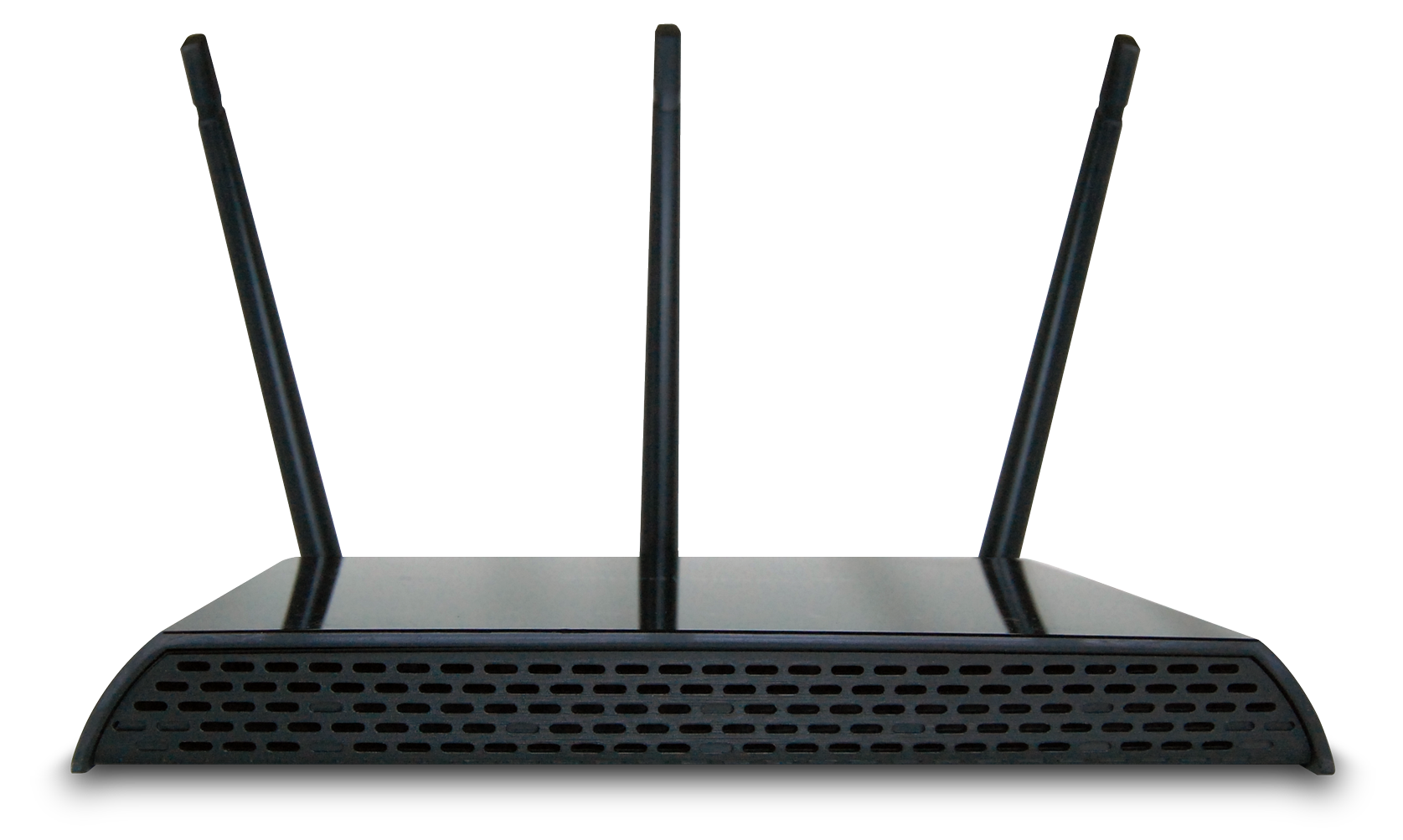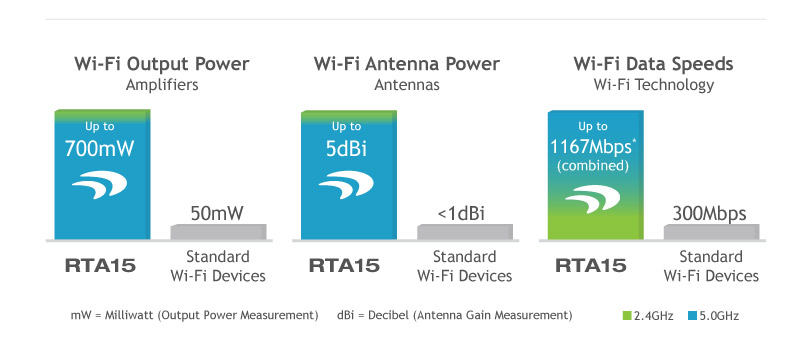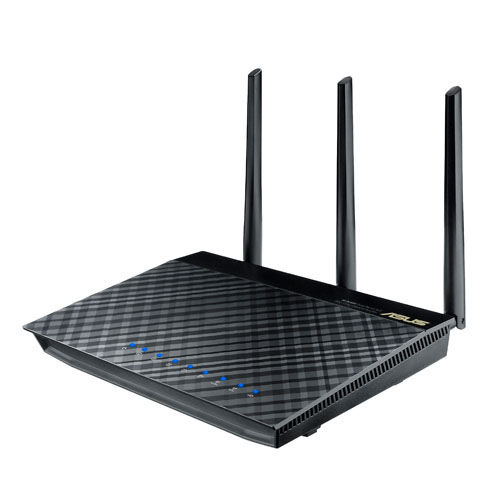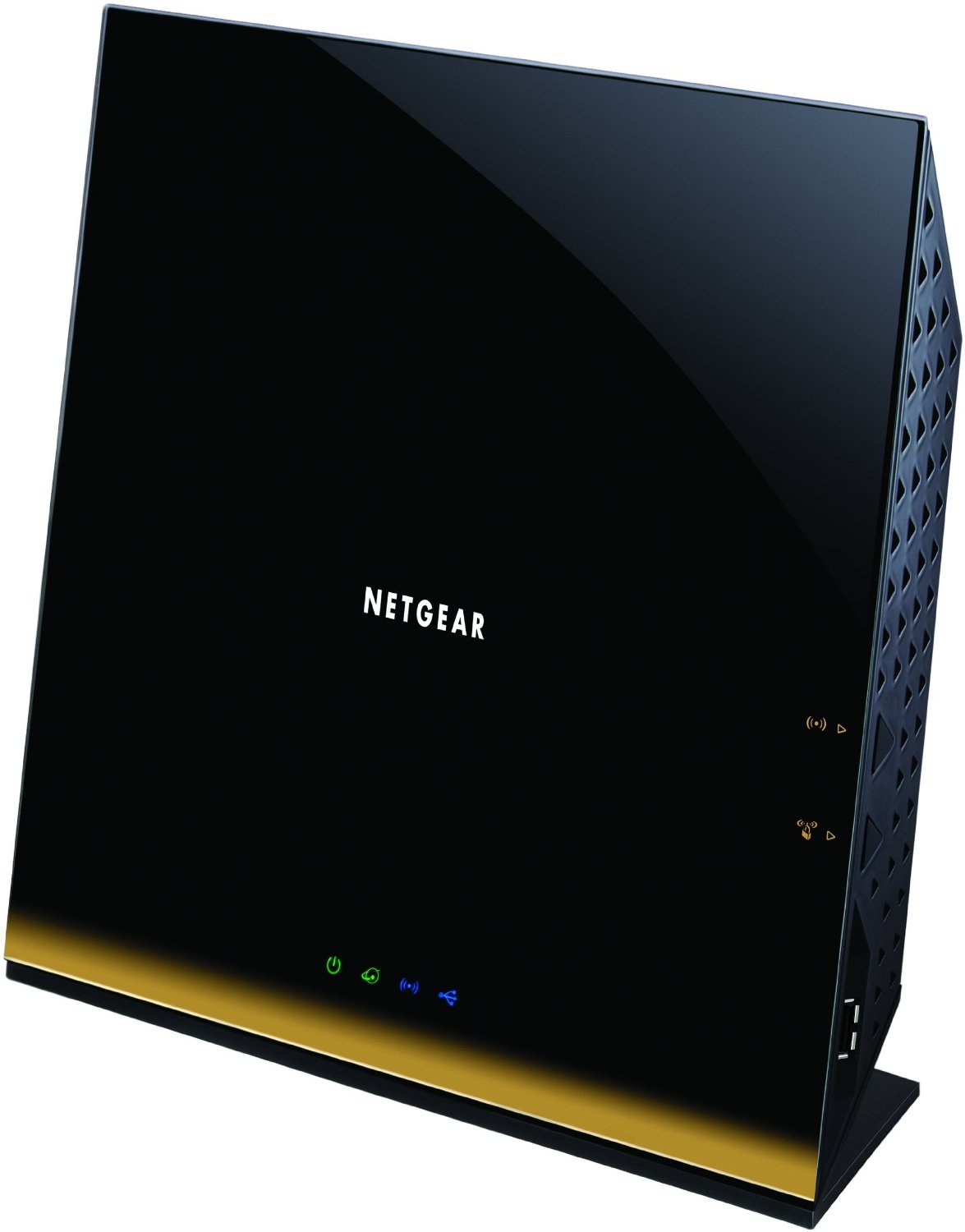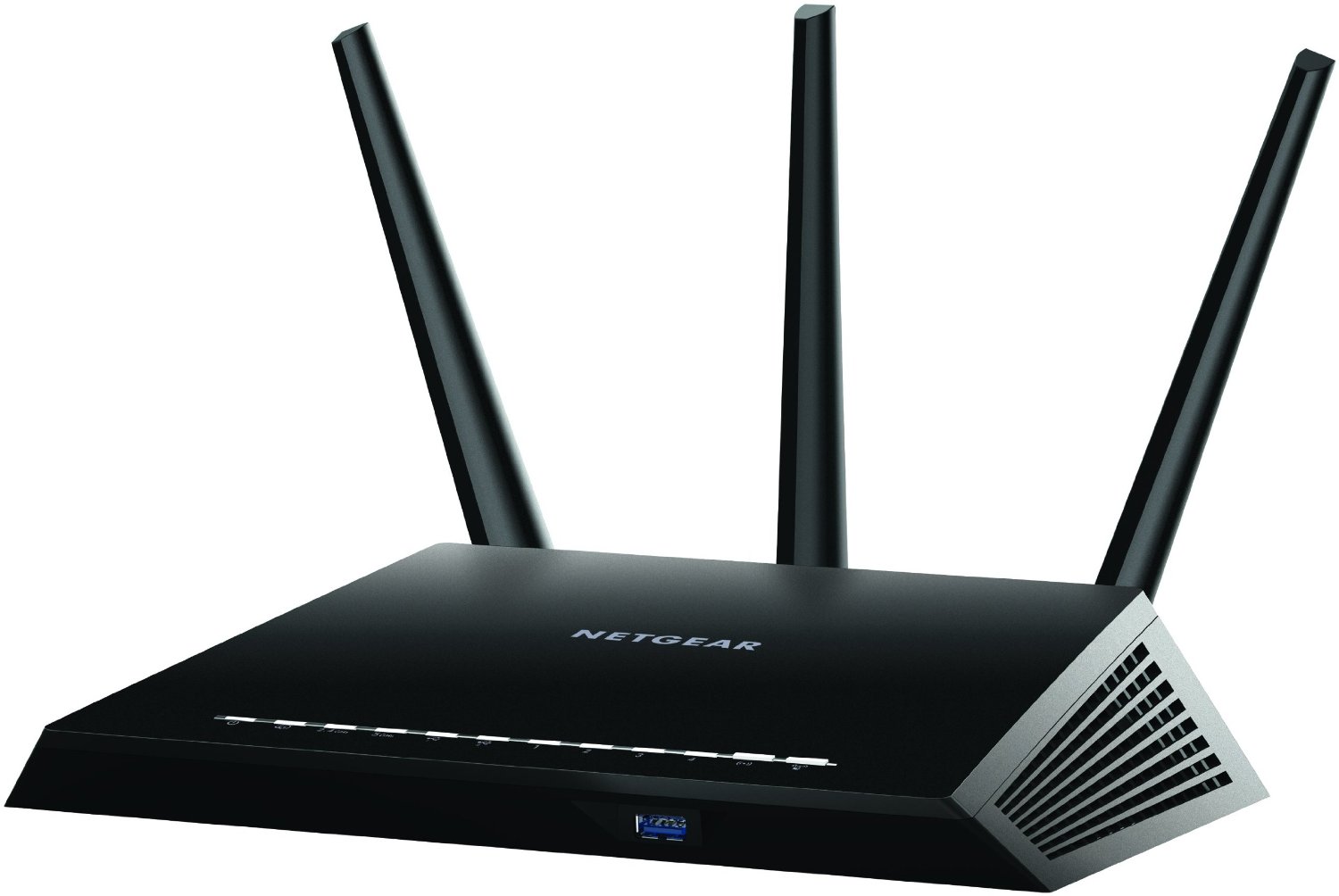802.11ac Wi-Fi Router Testing: Interference And Workloads
The Routers
Amped Wireless RTA15
When it stormed into the 11ac scene in 2013, Amped Wireless sought to make a name for itself in the areas of performance and range, promising “up to three times greater coverage than standard 802.11ac routers.” The key explanation from Amped’s literature explains: “A high power 700mW dual band, 802.11ac Wi-Fi router, the RTA15 features three high gain, 5dBi antennas and ten total power amplifiers, the most ever used in an Amped Wireless Wi-Fi product. The amplifiers include two 2.4GHz 700mW amplifiers, four 5.0GHz 700mW, 2-Stage amplifiers, and four advanced, low noise amplifiers. The cutting-edge technology packed into the RTA15 gives it the ability to stream high quality media at faster speeds to multiple devices at once, with ease.”
The RTA15 provides a theoretical 300 Mb/s on its 2.4GHz band plus 867 Mb/s over its 5GHz radios, making it an AC1200-class product that still retails for $160. Realize that the RTA15 uses a 2x2 antenna array, so AC1200 is the best you’re going to see. Stepping up into a 3x3 array potentially lifts the 2.4/5 mix to 450/1300 Mb/s, which is why 3x3 dual-band routers commonly advertise being “AC1750.” Of course, AC1750 costs more, so we wanted to see if a souped-up AC1200 like the RTA15 could hold its own against AC1750 technology or whether it would suffer the same fate as our formerly reviewed 2x2 11ac disaster, Belkin’s AC1200 DB.
Asus RT-AC66U
The darling of our prior round+up returns to see how it fares under harsher conditions. The AC66U was our clear victor under regular testing, leveraging its 3x3 array (AC1750) for most impressive results. We would love to pit a model like this against Asus' own four- and six-antenna routers someday to see if, when and how much diminishing returns set in as antenna counts (and prices) climb. For now, though, we’ll be content to see if our old assessments conducted with standard testing continue to hold up under these new, more challenging scenarios. As it is, the A66U still sells for $155 on Amazon.
Netgear R6300
While it delivered fair performance previously, we wanted the R6300 in this mix to see if Netgear’s 3x3 configuration might have some unexpected twists waiting in it. Now only $127, it would be a coup if this AC1750 router could pull a rabbit out of its hat, especially being one of the few models around with internal antennas. Note that Netgear’s follow-up, Nighthawk, reverts to using external antennas. There may be a lesson there.
Netgear Nighthawk R7000
If the R7000 uses a 3x3 antenna configuration, why does it advertise AC1900 rather than AC1750? The 5GHz spec still notes a top-end 1300 Mb/s throughput. However, the 2.4GHz side ratchets up to a theoretical 600 Mb/s if the client has matching “performance mode” support for 256-QAM. Our 3x3 802.11ac Asus client adapter (the PCE-AC68), one of the few client options available during our testing, only supports up to 64-QAM, so we missed this little perk. Even today, Intel’s top integrated 11ac client adapters for notebooks, the Dual Band Wireless-AC 7260 and 7265, are 2x2 (AC1200) products, so we feel we’re still hitting near the top of current client capabilities. Other sites have examined AC1900 client performance and found it to be equivalent to AC1750 at best. Regardless, you will still pay a premium for the Nighthawk R7000 at $184.
Get Tom's Hardware's best news and in-depth reviews, straight to your inbox.
-
jacobian In "How we tested" you didn't specify what kind of wi-fi hardware the test clients had. Was it PCIe or USB network adapter? What kind of MIMO setup, e.g. 3x3 or 2x2?Reply
-
chimera201 I would like to see tear-down of routers to see the components for making a guess at longevity.Reply -
CaedenV This was a much better test setup, and a really interesting read. Only complaint was that the nighthawk may have an unfair advantage in the interferance tests compared to the other units as it went up against the 66U instead of another nighthawk. Perhaps you could dig up a 5GHz N router to act as a standard interference device next time? Or find a cheap AC router? It would make it a much better apples-to-apples comparison.Reply
At any rate, great article! I will certainly send this to my more tech-savvy friends who are looking to upgrade from N right now. I have the 66U in my own home and this seems to be spot-on which what I experience relating to distance and obstructions. It is not necessarily the fastest router on the market, but it is nice an consistent which has merits. -
dgingeri Home router security is so poor, I wouldn't even think of using one. Let me guess, they all have WPS, right? HUGE security hole that nobody ha made one little tiny step in fixing, and is "featured" on nearly every home router.Reply -
Larry Litmanen I use to have constant WiFi issues, one day i went out and got the best router i could, still had issues. Calling them for support was hell, 45 minutes on the phone just to be told "Sorry sir but there's nothing wrong with our router, your internet is down".Reply
I found out that my cable/internet company provides a free router, they hooked it up..............no issues since. Heck they just gave me a free AC router that can be controlled from internet.
I will not be buying any more routers. -
@dgingeri, I've never seen a router that didn't have the option to disable WPS. And WPS is better than nothing for non-technical people.Reply
Cool article. -
dgingeri Reply15852608 said:@dgingeri, I've never seen a router that didn't have the option to disable WPS. And WPS is better than nothing for non-technical people.
Cool article.
WPS can't be turned disabled by software. That's the big problem with it. My last two routers and one AP got hacked through WPS, even though it was disabled in software. That's when I learned that it doesn't actually get turned off. The only way to protect against the WPS security hole is if the software running the router or AP doesn't support WPS. This can be done by either getting an AP or router without that feature (quite difficult and rather expensive) or putting an opensource software on your router that doesn't have support for WPS (more difficult, but somewhat less expensive.)
As for "better than nothing for non-technical people", that's pretty much asinine. That's like saying "someone can't operate the key, so we'll leave this side door open." -
dgingeri Reply15852434 said:I use to have constant WiFi issues, one day i went out and got the best router i could, still had issues. Calling them for support was hell, 45 minutes on the phone just to be told "Sorry sir but there's nothing wrong with our router, your internet is down".
I found out that my cable/internet company provides a free router, they hooked it up..............no issues since. Heck they just gave me a free AC router that can be controlled from internet.
I will not be buying any more routers.
Did you know the ISP free routers have a back door for support purposes. They couldn't support them if they didn't have that back door. The big problem with that is that every support person, and former support person, for that company knows that back door. A vengeful or malicious former employee could easily hack into any customer's router and insert tracking software or "listen in" on the internet traffic, capturing all your passwords. They also have other massive security holes. ISPs patch their router firmware for bugs or security holes even less often than home router manufacturers. They aren't safe.
-
liquidpower this is the most important part of the Client how could you not included it?ReplyIn "How we tested" you didn't specify what kind of wi-fi hardware the test clients had. Was it PCIe or USB network adapter? What kind of MIMO setup, e.g. 3x3 or 2x2?
-
bikeracer4487 So in the "Performance without Encryption" section, in the very first test you test how long it takes to copy a 2GB folder, with the results measured in seconds. The AC66U wins with the lowest time, and the R6300 having the SLOWEST time...and yet you wrote this: "The exception is the R6300, which takes a 10% to 20% jump. This is a strong enough leap to propel it into first place in our test. Could it be that the R6300 is in fact a far more capable speedster being held back by encryption processing? Or is it just luck and variable ambient test conditions?"Reply
